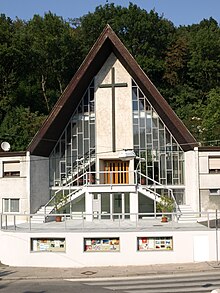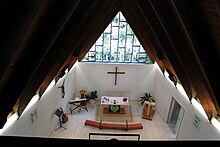Trinitatiskirche (Penzing)
The Trinity Church is an Evangelical Lutheran church building (Protestant parish of the Augsburg Confession) in the Hütteldorf district of Vienna's 14th district of Penzing at 20 Freyenthurmgasse.
history
The evangelical parish AB Wien Hütteldorf was founded on December 6, 1954 as an independent parish and was able to purchase the building site on December 4, 1963 following an inheritance.
Between 1967 and 1968 the church was built according to plans by architect Sepp Schuster and officially opened by Pastor Heinz W. Becker for the Trinity Festival in 1968.
After the retirement of Pastor Heinz W. Becker, Pastor Hartmut Schlener took over the parish of Hütteldorf in 1984.
An extension was completed in 1992 under Pastor Hartmut Schlener and a further two-story extension was opened in 1994.
In 1998, in the presence of Bishop Herwig Sturm, the foundation stone for a Diakonie garden house was laid on the parish grounds , which Superintendent Werner Horn handed over to its destination in 1999 for the Thanksgiving Day . After more than 35 years of existence, the church window fronts and the church interior were renovated and revised in an initial renovation phase in 2005. The 40th anniversary of the church consecration in 2008 was a new impetus to take on the renovation of the church stairs, forecourt and the adaptation of the entire system (installation of a passenger lift) to meet the needs of the disabled. The project was completed with the topping-out ceremony on September 25, 2010 and the official opening on May 7, 2011 by Superintendent Hansjörg Lein .
A youth church house was built on the parish grounds from May 29, 2009 to May 7, 2011 to organize open youth work. With the installation of solar collectors on the flat roof in 2001 and high-quality gas condensing boilers, the parish set ecological initiatives in motion in the diocese at an early stage.
The parish increased its support for the hearing and visually impaired by delegating pastoral care to three institutions in the mid-1980s: the deaf-and-dumb pastoral care, the service for the hard of hearing and the pastoral care for the blind and visually impaired for Vienna, Lower Austria and Burgenland, which continue to do so are connected to the Hütteldorfer parish office. At the end of the 1980s, the community played a key role in founding the Christoffel-Blindenmission association and initially accompanied the office work in Purkersdorf (today, Light for the World ).
Pastor Hartmut Schlener initiated the first aid transports to Poland in October 1998 as part of the Diakoniaustrages , which were raised through donations in kind by the community. The aid transports were then carried out annually to Romania by partner communities in Schäßburg and Sibiu .
Through the work of Pastor Schlener, who was elected chairman of the Gustav-Adolf-Verein, the administrative headquarters of the Gustav-Adolf-Verein Wien and the Gustav Adolf-Verein in Austria are located in the parish office of the Trinity Church. The diaspora association is the oldest active aid association of the Evangelical Church AB for church building maintenance throughout Austria and was founded in 1861. Since the work of this community, care for refugees has been intensified.
architecture
The church service community looks through a large altar window onto a permanently blooming altar bed and further onto the so-called Paradise Grounds, a publicly accessible wooded area of Vienna. Nature elevates worship to a special reference to creation. The high gable with glass facade, the wooden gable roof and a large Trinity altar window are striking. The interior is designed as an equilateral triangle according to the Trinity-Trinity symbolism.
Outwardly characterized by a high gable and a glass facade, the church has a large Trinity altar window with a view of the outside. In the entire nave (which is shaped like a tent roof), the symbol of the Holy Trinity is artistically dominant. The parish previously owned a chapel and a makeshift parish house on the neighboring property (number 18) in front of the residence of Bishop Gerhard May (term of office 1944–1968). The property, the property of the Evangelical Upper Church Council of the Augsburg Confession, came to them in 1921 as a gift from American Lutherans, combined with the requirement to build a children's home here.
Web links
Individual evidence
- ↑ Protestant religious instruction . Retrieved October 9, 2019 .
- ^ History. November 2, 2018, accessed October 9, 2019 .
Coordinates: 48 ° 12 ′ 19.2 " N , 16 ° 15 ′ 25.7" E




